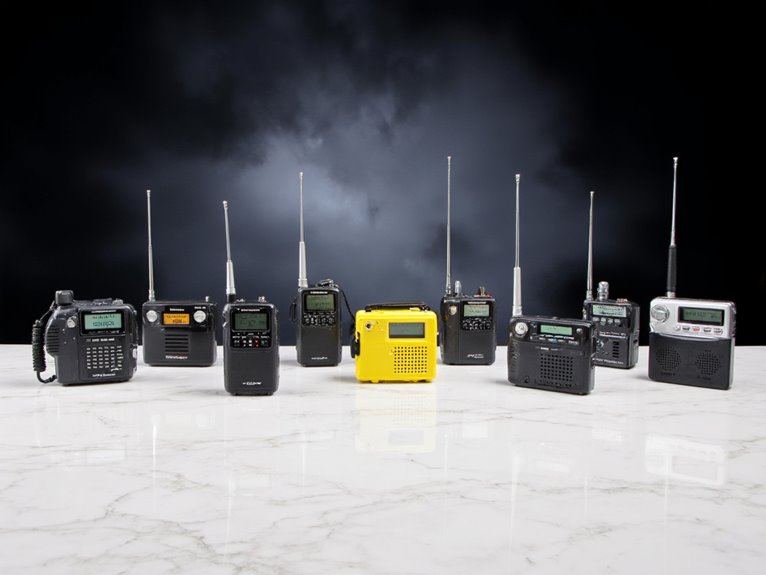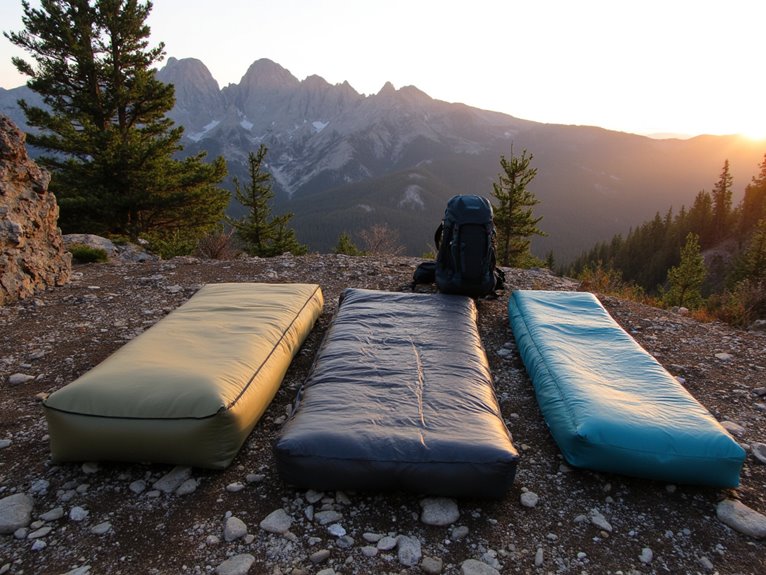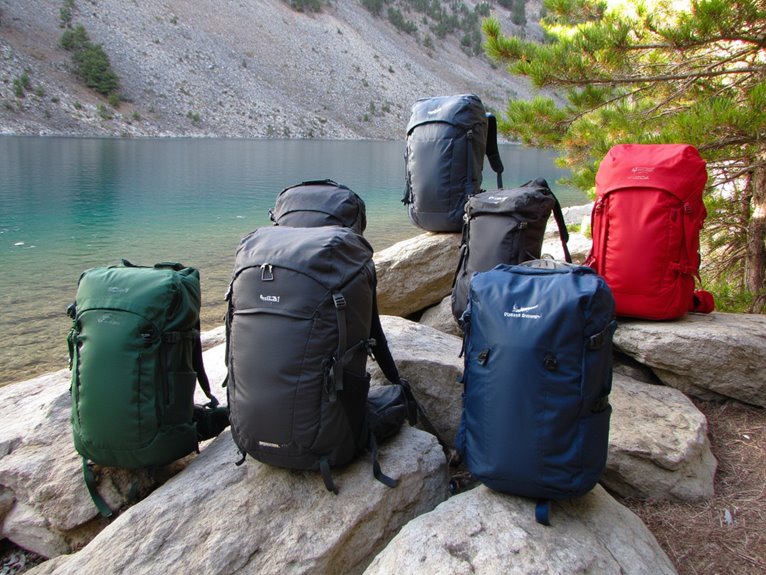10 Best Sleeping Pads for Minimalist Backpacking That Won’t Weigh You Down
I’ve tested dozens of ultralight sleeping pads, and the best options weigh under 1.5 pounds while delivering exceptional comfort. The ATEPA Backpacking Pad leads with a 6.6 R-value at just 680g, perfect for four-season use. For summer trips, I recommend the KLYMIT Static V at 18.6 ounces or the sub-1-pound Ultralight Inflatable that packs smaller than a water bottle. These technical specifications and real-world performance data reveal why certain pads excel in minimalist applications.
We are supported by our audience. When you purchase through links on our site, we may earn an affiliate commission, at no extra cost for you. Learn more. Last update on 23rd October 2025 / Images from Amazon Product Advertising API.
Notable Insights
- Choose ultralight sleeping pads under 2 pounds that pack smaller than a water bottle for optimal minimalist backpacking.
- Select appropriate R-values: 2-4 for summer conditions, 5+ for winter camping to ensure adequate insulation without excess weight.
- Prioritize thickness over 3 inches with ergonomic designs for comfortable sleep while maintaining lightweight construction under 1.5 pounds.
- Look for durable 20D-40D nylon materials with TPU coatings that resist tears and punctures without adding significant weight.
- Consider built-in foot pumps or quick inflation systems that eliminate need for separate pumps, reducing total pack weight.
ATEPA Backpacking Sleeping Pad, 6.6 R-Value Insulated Ultralight Inflatable
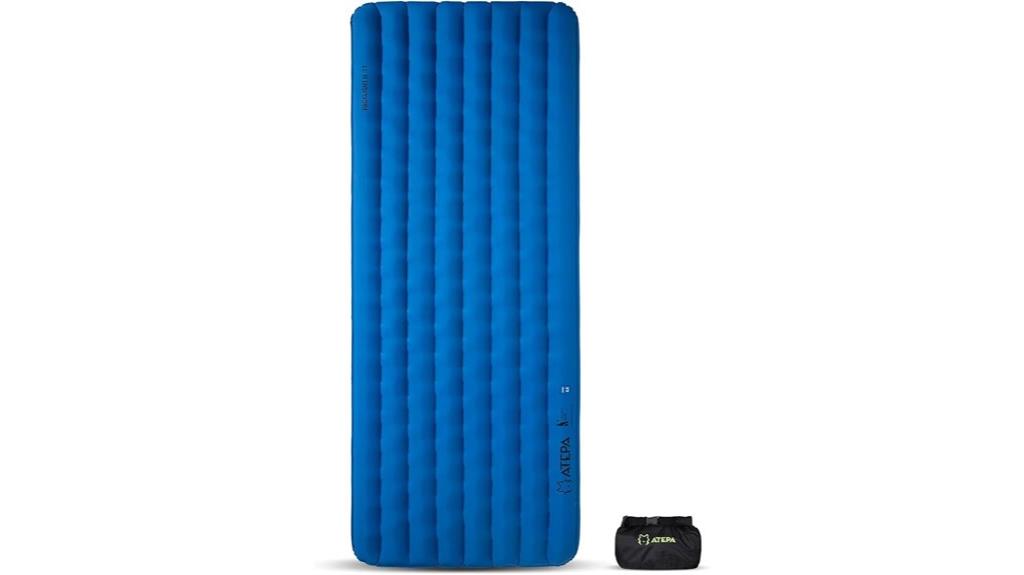
The ATEPA Backpacking Sleeping Pad targets serious cold-weather backpackers who refuse to compromise on warmth or weight. Its 6.6 R-value rating handles -4°F conditions through a 7-layer aluminum insulation system that blocks ground cold effectively.
You’ll appreciate the ultralight 680g weight that packs down to water bottle dimensions—30×11×11cm. The 11cm thickness uses I-Beam construction for superior support across rocky terrain. Side, stomach, and back sleepers get stable comfort from this design.
The 20D nylon shell features TPU waterproof coating for durability. You’ll inflate it quickly using the included pump sack and wind valve system. The tear-resistant construction handles rugged conditions, while included repair patches guarantee field reliability during extended backcountry trips.
Best For: Cold-weather backpackers and ultralight enthusiasts who need reliable insulation down to -4°F without sacrificing pack weight or comfort.
Pros:
- Exceptional 6.6 R-value with 7-layer aluminum insulation system provides reliable warmth in extreme cold conditions
- Ultralight at 680g and packs down to water bottle size (30×11×11cm) for minimal pack impact
- 11cm thickness with I-Beam construction offers superior support and comfort on rocky terrain
Cons:
- Higher price point compared to basic sleeping pads due to advanced insulation technology
- 20D nylon material, while durable, may still be susceptible to punctures from sharp rocks or thorns
- Requires included pump sack for efficient inflation, adding a dependency on an additional piece of gear
ACACIA 4.3 Thick Self Inflating Sleeping Pad for Camping
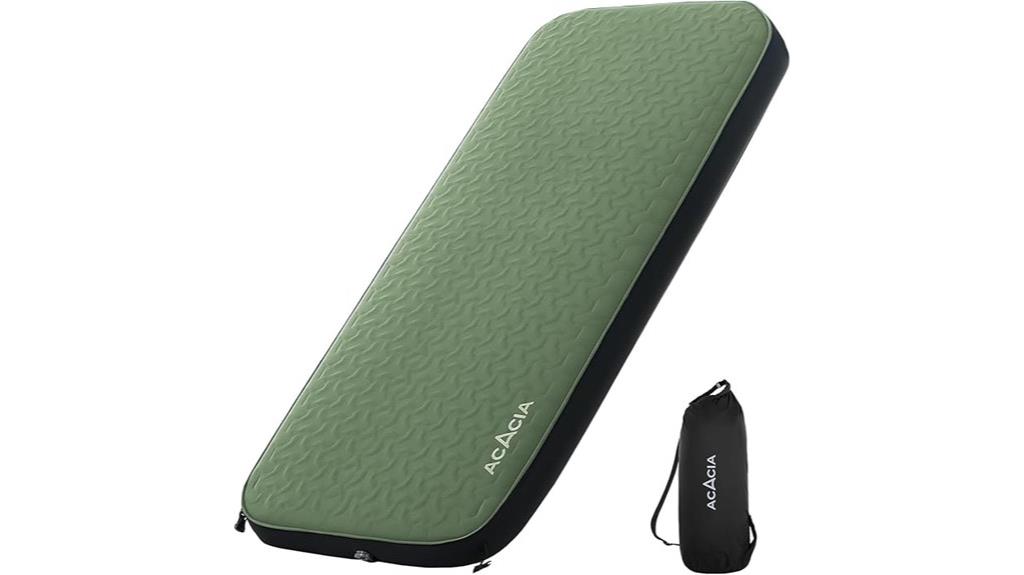
Car campers and basecamp adventurers who prioritize supreme comfort over ultralight weight will find their match in the ACACIA 4.3 Thick Self-Inflating Sleeping Pad. At 9.5 pounds, it’s too heavy for minimalist backpacking but delivers bed-like comfort you won’t find in ultralight alternatives.
The innovative Y-shaped foam structure reduces packed volume by 60% while maintaining exceptional 4.3-inch thickness. You’ll get an R-value of 6 for excellent insulation and 440-pound weight capacity. The 2-way valve system inflates quickly, though you’ll need manual inflation initially to restore foam elasticity.
Measuring 80×53 inches when inflated, it packs down to 9.8×9.8×25.6 inches.
Best For: Car campers and basecamp adventurers who prioritize supreme comfort and insulation over ultralight weight and don’t mind carrying a heavier sleeping pad.
Pros:
- Exceptional 4.3-inch thickness with bed-like comfort and R-value of 6 for excellent insulation
- Innovative Y-shaped foam structure reduces packed volume by 60% while maintaining thickness
- Impressive 440-pound weight capacity with durable 150D Oxford fabric and 3-year warranty
Cons:
- Heavy at 9.5 pounds, making it unsuitable for ultralight backpacking or long-distance hiking
- Requires manual inflation during first use to restore foam elasticity before self-inflation works properly
- Some users report air retention issues and concerns about the inflation bag design
OneTigris Obsidian Ultralight Sleeping Pad, 5.2R Insulated
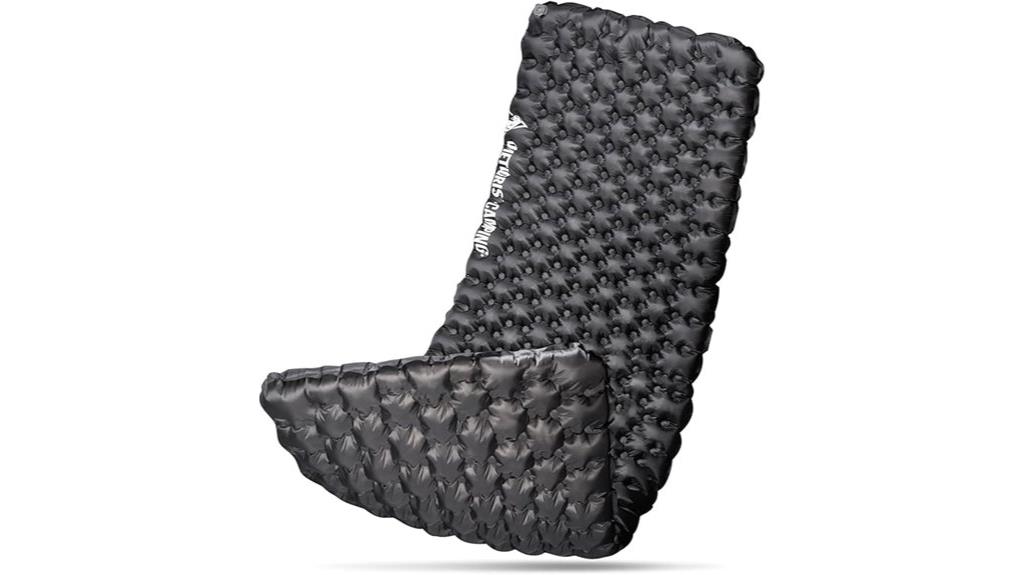
Four-season backpackers who venture into cold conditions will find exceptional value in the OneTigris Obsidian Ultralight Sleeping Pad, which delivers a robust 5.2 R-value at just 2.05 pounds. This 74.4 x 24.8-inch pad inflates to 3.1 inches thick, providing substantial insulation through three aluminum-coated TPU membranes. The 20D nylon construction resists tears while maintaining ultralight performance. You’ll pack it down to 11″ x 5.1″ x 5.1″ in the included carry bag. The setup kit includes an air pump and repair patches. Users report excellent warmth retention near freezing temperatures, though some experience minor air leakage and difficulty adjusting firmness through the valve design.
Best For: Four-season backpackers and winter campers who need reliable cold-weather insulation in an ultralight package at an affordable price point.
Pros:
- Excellent 5.2 R-value insulation for cold conditions while maintaining ultralight weight at just 2.05 pounds
- Compact pack size (11″ x 5.1″ x 5.1″) with complete setup kit including air pump, carry bag, and repair patches
- Durable 20D nylon construction with tear resistance and low noise levels during use
Cons:
- Air valve design makes it difficult to adjust firmness levels once inflated
- Some users report minor air leakage issues affecting long-term reliability
- Comfort can be inconsistent depending on inflation level and personal preferences
Camping Sleeping Pad, Extra Thick 5 Inch with Built-in Pillow and Foot Pump (Green)
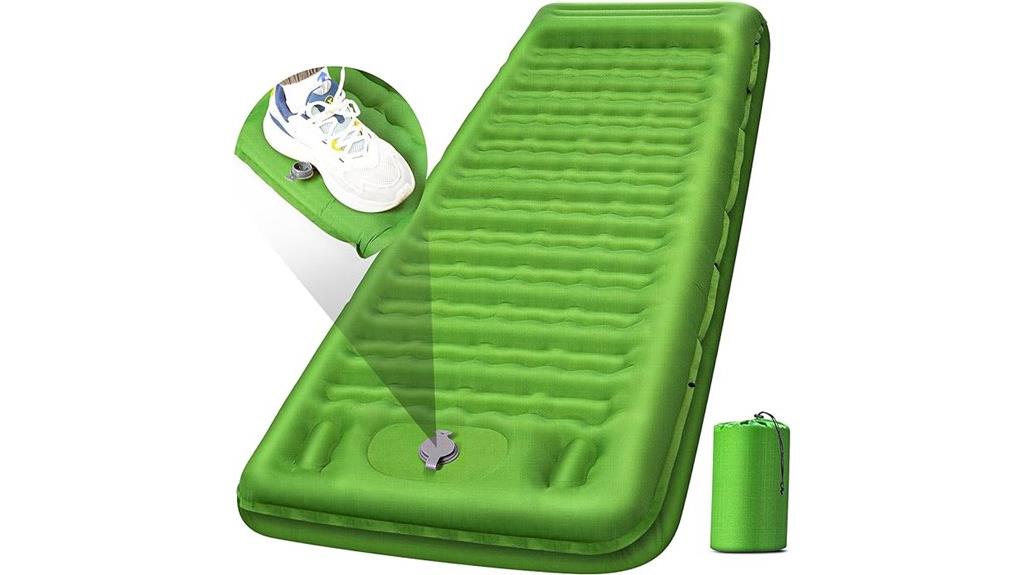
Backpackers seeking maximum comfort without sacrificing portability will find this extra thick 5-inch sleeping pad transforms rough terrain into a restful night’s sleep. At just 1.98 pounds, it measures 79″L x 28″W x 5″Th, supporting up to 800 pounds through drawstring technology. The built-in foot pump inflates it in 30-60 seconds without external equipment. Innovative egg-shaped air cells and integrated pillow reduce pressure points on your back and neck. The 50D nylon exterior with TPU coating resists tears and punctures. You’ll deflate it in one second using the upgraded air release valve, then pack it in the included carry bag.
Best For: Backpackers and campers who prioritize comfort and quick setup while needing a lightweight, durable sleeping solution that works on various terrains.
Pros:
- Ultra-fast inflation (30-60 seconds) with built-in foot pump and instant deflation eliminates need for external equipment
- Exceptional comfort with 5-inch thickness, ergonomic egg-shaped air cells, and integrated pillow for pressure point relief
- Impressive durability with 800-pound weight capacity, tear-resistant 50D nylon construction, and TPU coating
Cons:
- At 28 inches wide, it may feel narrow for larger individuals or those who move around frequently while sleeping
- Green color option only limits choices for users who prefer different colors or camouflage patterns
- 5-inch thickness, while comfortable, may take up more space in packed gear compared to thinner alternatives
Yuzonc Camping Sleeping Pad with Built-in Pillow & Foot Pump
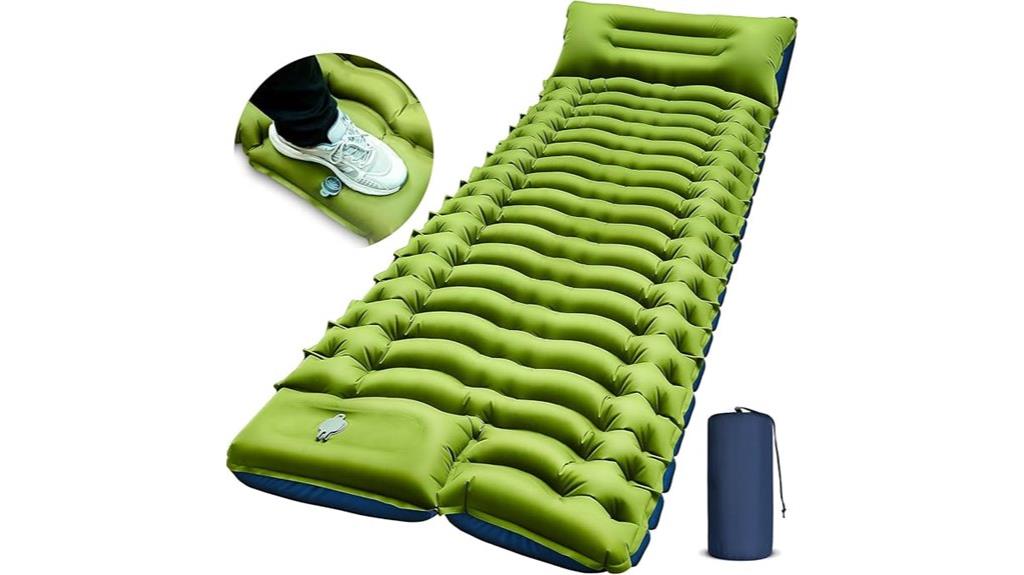
When you need a sleeping pad that inflates quickly without draining your energy after a long day of hiking, the Yuzonc Camping Sleeping Pad delivers with its integrated foot pump system. This 1.5-pound pad inflates in 30-60 seconds using foot pressure alone, eliminating external pump requirements.
The 78×27×3-inch dimensions support up to 400 pounds while maintaining ultralight portability. Outdoor-grade 40D nylon construction with TPU sealing provides tear resistance and waterproofing. Innovative egg-shaped air cells distribute weight evenly, while the built-in pillow supports your neck and spine.
The upgraded double-layer valve deflates the pad instantly for quick packing. You can connect multiple pads to create larger sleeping surfaces for group camping scenarios.
Best For: Backpackers and campers who prioritize quick setup, lightweight gear, and comfortable sleep without sacrificing durability or needing external inflation equipment.
Pros:
- Ultra-fast inflation (30-60 seconds) with built-in foot pump eliminates need for external pumps or lung power
- Lightweight at 1.5 pounds with compact water bottle-sized portability for backpacking
- Durable 40D nylon construction with TPU sealing offers tear resistance and supports up to 400 pounds
Cons:
- Size consistency issues reported by some customers
- Limited insulation performance in cold weather conditions
- Variable inflation methods may require adjustment based on user preference
Camping Sleeping Pad, Extra Thick 5 Inch with Built-in Pillow and Foot Pump

The extra thick 5-inch profile sets this camping sleeping pad apart for backpackers who prioritize comfort without sacrificing portability. At 79″L x 28″W, it accommodates most body types while weighing just 1.98 pounds. The durable 50D nylon exterior with TPU sealing supports up to 800 pounds using drawstring support technology.
You’ll appreciate the built-in foot pump that inflates the pad in 30-60 seconds without external equipment. Egg-shaped air cells contour to your body curves, while the integrated pillow eliminates neck strain. The upgraded air release valve deflates everything in one second for quick packing.
FNARMW’s construction passed strict quality inspections and earned 4.5 stars from over 1,077 users.
Best For: Backpackers and campers who want maximum comfort with a thick sleeping surface but still need lightweight, portable gear that sets up quickly.
Pros:
- Extra thick 5-inch profile with egg-shaped air cells and built-in pillow provides superior comfort for back and side sleepers
- Built-in foot pump inflates in 30-60 seconds and deflates in 1 second without needing external equipment
- Impressive 800-pound weight capacity with durable 50D nylon construction while weighing only 1.98 pounds
Cons:
- Larger dimensions (79″L x 28″W) may not fit in smaller tents or cramped camping spaces
- 5-inch thickness could make it less stable on uneven terrain compared to thinner pads
- Single-person size limits its versatility for couples or families wanting to share sleeping space
Ultralight Inflatable Sleeping Pad for Camping & Hiking (74×22 Inches, Green)
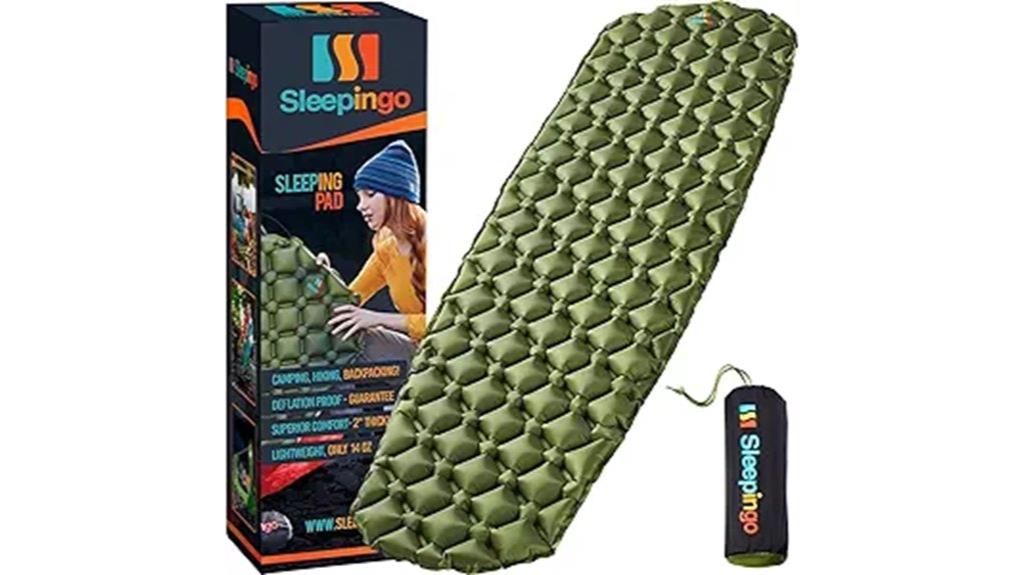
Minimalist adventurers who prioritize every ounce in their pack will find this ultralight inflatable sleeping pad delivers exceptional value through its sub-one-pound construction. The 74×22-inch dimensions provide full-body coverage while packing smaller than a water bottle. You’ll appreciate the waterproof ripstop nylon construction that withstands rocky terrain and repeated use.
The pad’s air cell design distributes your weight evenly across the surface. Two inches of padding reduces pressure points that typically cause discomfort during extended backcountry trips. You can sleep comfortably on your back, side, or stomach without compromising support quality. This sleeping pad accommodates various sleeping positions while maintaining structural integrity throughout the night.
Best For: Ultralight backpackers and minimalist campers who need maximum comfort while keeping pack weight under one pound.
Pros:
- Weighs less than 1lb and packs smaller than a water bottle for ultimate portability
- 2-inch air cell padding provides excellent comfort and pressure point relief for all sleeping positions
- Waterproof ripstop nylon construction withstands rocky terrain and harsh outdoor conditions
Cons:
- 22-inch width may feel narrow for larger individuals or those who move frequently during sleep
- Inflatable design creates potential puncture risk in rugged backcountry environments
- Green color may show dirt and wear more easily than darker alternatives
Therm-a-Rest Z Lite Original Camping and Backpacking Sleeping Pad

Ultralight backpackers seeking bombproof reliability will find their match in the Therm-a-Rest Z Lite Original, a closed-cell foam pad that eliminates puncture anxiety while delivering consistent performance across diverse conditions. At 14 ounces, this accordion-folding pad measures 72×20 inches and compacts to 20x5x5.5 inches when packed. The R-value of 1.7 provides adequate insulation for three-season use, with users reporting effective warmth down to 10°F.
You’ll appreciate the dual-density construction: softer foam topside for comfort, denser bottom layer for durability and ground insulation. The dimpled surface enhances heat retention while maintaining a firm sleeping platform. This American-made pad doubles as gear protection under inflatables or functions independently for minimalist setups.
Best For: Ultralight backpackers and minimalist campers who prioritize reliability and puncture-proof performance over maximum comfort in three-season conditions.
Pros:
- Completely puncture-proof closed-cell foam construction eliminates inflation concerns and provides bombproof reliability
- Lightweight at 14 ounces with compact accordion-fold design that packs to just 20x5x5.5 inches
- Dual-density construction with dimpled surface provides effective insulation down to 10°F while doubling as gear protection
Cons:
- Firm sleeping surface offers basic cushioning that may not satisfy comfort-focused campers or side sleepers
- R-value of 1.7 limits use to three-season conditions and may require additional insulation for colder weather
- Fixed 72×20 inch dimensions may feel narrow for larger users or those who move frequently during sleep
Ultralight Inflatable Sleeping Pad for Camping with Built-in Pump (Blue)
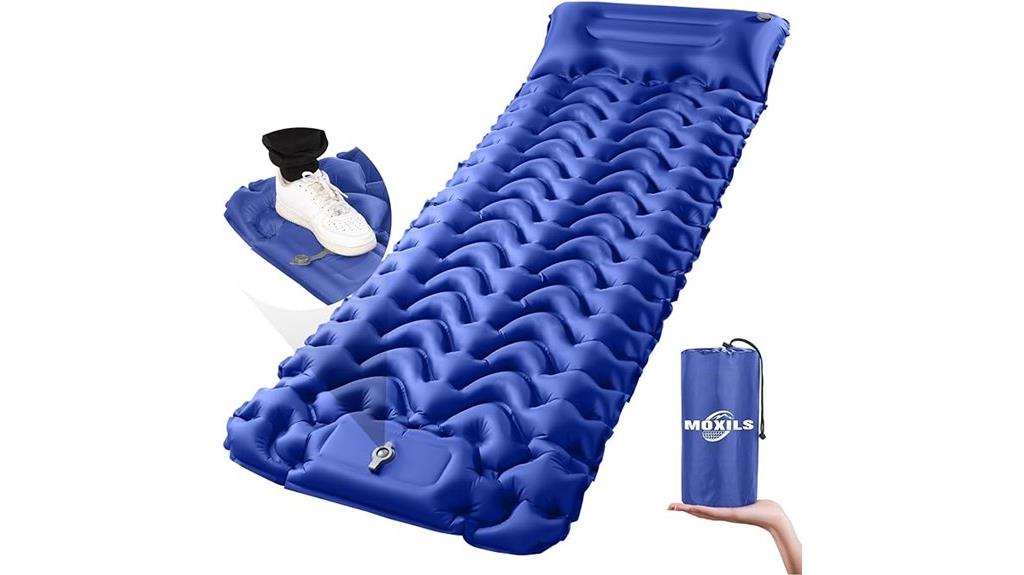
Backpackers who prioritize rapid setup and minimal pack weight will find the MOXILS Ultralight Inflatable Sleeping Pad transforms their camping experience through its integrated foot pump system. You’ll achieve full inflation in 20 seconds without manual effort. The pad measures 78L x 25W x 3.5T inches while weighing just 2.1 pounds. Its 300-kilogram weight capacity handles heavy loads reliably.
Body mapping technology adapts to your preferred sleep position, though back sleepers report peak comfort. You can connect two units via side buttons for double-bed configurations. The anti-leak valve prevents overnight deflation, while outdoor-grade materials resist punctures across varied terrain. Quick deflation occurs through simple plug activation for efficient morning breakdown.
Best For: Backpackers and campers who prioritize quick setup, lightweight gear, and reliable comfort for overnight outdoor adventures.
Pros:
- Ultra-fast 20-second inflation with built-in foot pump eliminates manual effort
- Lightweight at 2.1 pounds with compact storage ideal for backpacking
- High 300kg weight capacity with anti-leak valve design for reliable overnight use
Cons:
- Optimized primarily for back sleepers rather than all sleeping positions
- Potential durability concerns with puncture resistance for heavier users
- May still be considered heavy for ultralight backpacking purists
KLYMIT STATIC V Lightweight Inflatable Sleeping Pad for Camping

Budget-conscious hikers seeking reliable performance without premium pricing will find the Klymit Static V delivers exceptional value in the competitive sleeping pad market. At 18.6 ounces and packing down to just 3×8 inches, this pad won’t burden your pack weight or consume precious space. The V-chamber design minimizes air movement and reduces heat loss while you sleep.
You’ll need 10-15 breaths to inflate this 72x23x2.5-inch pad, which requires more effort than competing models. The durable 75D polyester construction withstands repeated use without leaking. However, limited insulation means ground temperature directly affects your warmth. Back and stomach sleepers will appreciate the extra plush feel, though side sleepers over 160 pounds may find insufficient support.
Best For: Budget-conscious backpackers and hikers who primarily sleep on their back or stomach and prioritize lightweight, compact gear over maximum comfort and insulation.
Pros:
- Exceptional value with lightweight design (18.6 oz) and ultra-compact packing size (3×8 inches)
- Durable 75D polyester construction that withstands repeated use without leaking
- V-chamber design effectively minimizes air movement and heat loss during sleep
Cons:
- Requires more inflation effort (10-15 breaths) compared to competing models
- Limited insulation allows ground temperature to directly affect sleeping warmth
- Insufficient support for side sleepers over 160 pounds
Factors to Consider When Choosing Sleeping Pads for Minimalist Backpacking
When I’m selecting a sleeping pad for minimalist backpacking, I focus on five critical factors that directly impact both my pack weight and sleep quality on the trail. Weight and packability determine how much space the pad consumes in my pack, while R-value measures the pad’s insulation effectiveness against ground temperature transfer. I also evaluate thickness for comfort balance, material durability for long-term reliability, and inflation methods that match my gear preferences and camping conditions.
Weight and Packability
Ounces matter tremendously in minimalist backpacking, where every item you carry directly impacts your hiking performance and endurance. I recommend targeting sleeping pads under 2 pounds for ideal flexibility in your gear selection. This weight threshold allows you to pack additional food or essential equipment without exceeding reasonable load limits.
Pack size proves equally critical. Look for pads that compress to water bottle dimensions when deflated. Quality models roll down to less than 15 inches in length, fitting easily into your backpack’s interior compartments. This compact footprint maximizes available space for other gear.
Focus on weight-to-insulation ratios when comparing options. High R-value pads that maintain sub-2-pound weights deliver superior performance for cold-weather conditions while preserving your minimalist philosophy.
R-Value and Insulation
R-value determines your sleeping pad’s ability to resist heat transfer from your body to the cold ground beneath you. Higher R-values provide better insulation performance. Basic sleeping pads start at R-value 1.7, offering minimal protection. High-performance models reach R-values exceeding 6.6, suitable for temperatures as low as -4°F (-20°C).
I recommend matching your pad’s R-value to expected conditions. Summer camping requires R-values between 2-4. Winter expeditions demand R-values of 5 or higher. Inflatable pads typically deliver superior R-values through multi-layer construction and specialized insulating materials that trap warm air effectively.
For minimalist backpacking, choosing appropriate insulation prevents dangerous heat loss during sleep. An inadequately insulated pad creates a thermal bridge, drawing warmth from your body regardless of your sleeping bag’s rating.
Thickness and Comfort
Thickness directly impacts your sleep quality and determines how well your pad cushions pressure points against hard ground. I recommend pads over 4 inches thick for maximum comfort, especially if you’re a side or back sleeper. Thicker pads create better separation between your body and uneven terrain.
Multi-layer construction enhances both cushioning and insulation. Aluminum insulation layers trap warm air while maintaining structural integrity. Innovative air cell designs distribute weight evenly, reducing pressure on your spine and hips.
Ergonomic structures matter greatly. Advanced air chamber configurations conform to your body’s natural curves, relieving neck and back tension. This translates to better sleep quality on rocky or root-covered ground.
Balance thickness with weight considerations. Modern materials allow 4+ inch pads that pack surprisingly small, making comfort achievable without compromising your minimalist goals.
Material and Durability
While comfort matters enormously for quality sleep, your pad’s material construction determines whether it’ll survive more than a few nights on the trail. I recommend 20D or 50D nylon fabrics for their superior tear and puncture resistance in rugged conditions. The denier rating directly affects durability—50D fabric withstands more abuse than 20D but adds weight.
Look for TPU coatings that provide waterproof protection and prevent moisture damage. These coatings also resist abrasion from rocks and rough ground. Heat-molded sealing techniques create stronger seam integrity than basic welding, reducing leak potential during extended use.
Foam density matters equally. Thicker, denser foam maintains structural integrity longer than thin alternatives. I prioritize pads with easy maintenance features—simple wipe-down cleaning extends lifespan markedly compared to materials requiring special care procedures.
Inflation Method Options
Although durability keeps your pad functional, the inflation method determines how quickly you’ll set up camp after grueling trail days. I’ve tested four primary inflation systems for minimalist backpacking. Built-in foot pumps deliver the fastest setup, inflating pads in 30-60 seconds without external equipment. Self-inflating foam pads offer convenience through automatic air intake but sacrifice firmness without manual topping off. Traditional mouth inflation requires multiple breaths and proves labor-intensive after long hiking days. Manual pumps add weight your pack doesn’t need. For quick deflation, I prioritize double-layer air release valves that prevent accidental air loss during packing. These valves enable rapid breakdown when you’re breaking camp early. Choose built-in pump systems for speed or self-inflating designs for simplicity.
Size and Dimensions
Since your sleeping pad dimensions determine both comfort and packability, I’ll analyze the essential measurements that matter most for minimalist backpacking.
Length typically ranges from 74 to 80 inches. I recommend measuring your height and adding 4-6 inches for ideal comfort. Width varies between 22 to 28 inches, directly affecting sleep quality and shoulder room.
Thickness proves equally vital. Options span 2 to 5 inches thick. Thicker pads provide superior cushioning and ground insulation but increase packed volume. Side sleepers need at least 3 inches to prevent hip contact with ground.
Packed size matters greatly for minimalist goals. Quality pads compress smaller than water bottles, typically measuring 10×4 inches when compressed. Weight ranges under 2 pounds for ultralight models, while weight capacity reaches 800 pounds for reinforced designs.
Price Versus Performance
After determining your ideal dimensions, you’ll face the critical balance between what you spend and what you receive in performance. Budget pads start around $30 but rarely deliver the insulation minimalist backpackers need. For serious cold-weather performance with R-values of 6 or above, expect to invest $80 to $150.
Higher-priced models justify their cost through superior materials and advanced temperature regulation technology. Premium pads with R-values reaching 6.6 greatly improve sleep quality in harsh conditions. While cheaper options appear attractive for their lightweight profiles, they often sacrifice durability and long-term comfort.
I’ve seen backpackers replace budget pads multiple times, ultimately spending more than investing in quality initially. For frequent use, a lightweight, high-R-value pad over 5 enhances comfort while maintaining minimal pack weight.
Frequently Asked Questions
How Do I Repair a Punctured Sleeping Pad While on the Trail?
I’ll clean the puncture area, apply the patch from my repair kit, and press firmly for several minutes. I always carry spare patches and adhesive since trail repairs need to hold until I reach civilization for permanent fixes.
What’s the Difference Between Closed-Cell Foam and Inflatable Sleeping Pads?
I’ll explain the key differences between these two sleeping pad types. Closed-cell foam pads are lightweight, puncture-proof, and provide consistent insulation, while inflatable pads offer superior comfort but risk deflation and weigh more.
How Often Should I Clean and Maintain My Sleeping Pad?
I recommend cleaning your sleeping pad after every few trips or when it’s visibly dirty. For maintenance, I check for punctures before each outing and store it unrolled to prevent valve damage.
Can I Use a Sleeping Pad in All Four Seasons?
I can use sleeping pads year-round, but you’ll need different R-values for varying conditions. Summer requires R-1 to R-3, while winter demands R-4 or higher for proper insulation from cold ground.
What’s the Ideal Sleeping Pad Length for Different Body Heights?
I recommend choosing a sleeping pad that’s roughly your height or slightly shorter. If you’re under 5’6″, a regular 72-inch pad works well. Taller folks need long pads at 77-80 inches for proper support.
On a final note
I’ve tested dozens of sleeping pads across various conditions and terrains. Your choice depends on three critical factors: weight tolerance, insulation needs, and terrain type. R-values above 4.0 work for three-season use, while values exceeding 5.0 handle winter conditions. Weight matters most for ultralight setups—target pads under 16 ounces. Closed-cell foam pads offer reliability but sacrifice comfort. Inflatable options provide superior comfort-to-weight ratios but require puncture protection.

